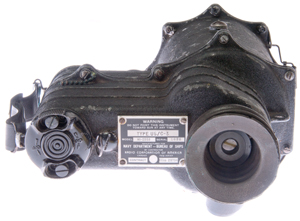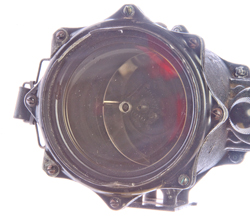US Navy Infrared Signaling Telescope US/C-3
© Brooke Clarke 2015 |
 |
Discovered a number of these on eBay while looking for military optical stuff. It appears to be a W.W.II vintage IR telescope. The Sniperscope (Wiki) and Snooperscope (Time 1963) were of the same vintage and use the same technology. After receipt and installing a couple of "D" cell batteries it worked. You can hear a hum when the inverter is running and as soon as it stops running the image tube goes dark. That probably means the the high voltage capacitor is leaky. The vibrator does not start every time the button is pressed. The points may need to be cleaned.
M2 Sniperscope with handle (Snooperscope)
heavy battery box, lamp + IR filter, Sniperscope.
YouTube: Forgotten Weapons: M3 Infrared Sniper Carbine at RIA
YouTube: Scarakus: History of Night Vision, (Progress in Night Vision), 1974, 22:29, Army R&D Report 53, Film No 2338
GEN1 - GEN2 - early thermal & FLIR..
2:32 W.W.II SniperScope
3:10 mid 1950s Fiber Optics
4:16 around 1960 Image Intensifiers. GEN1 has three series stages of light amplifiers, 40,000X brightness
5:32 GEN1 Family: (PVS-?) Vietnam 4X, 500m range, individual weapon, on M-1
6:30 TVS-2? Crew Served Weapon Sight, 7X, >1,000 meters,
7:10 Night Observation Device Medium Range, 7X, range thousands of meters, tripod mounted, 6" to 8" objective guess
8:13 GEN2 Family: Single stage, microchannel plate, 1/4 size, 1/2 weight, higher resolution PVS-4, on M-16
10:48 Night Vision Goggles, stereo, FOV: 40 deg, range: <= 100 meters (mon light), 50m (starlight),
12:46 Monocular Pocket Scope, 3X, can be used to read map, 1.5 lbs, FOV 15 deg, 375m (moon), 200m (star),
13:31 "Driver's Viewer" Combat Vehicle Sights (VVS-2?)
13:49 Thermal Viewer, <6 lbs + 5 lbs belt mounted battery, far infrared, (see: Probeye, DFOV),
15:56 M47 Dragon (Wiki), 10 lbs, 4X,
16:45 Combat Vehicle Thermal Night Sights
17:10 FLIR (Wiki)
18:37 Army, Navy & AF coordinating FLIR effort, civilian uses,
This is a near IR (not thermal IR) telescope without an associated illumination source. It's intended to see IR beacons or Aldis signal lights on ships with IR filters. It would also work to see the M-227 Signal Lamp Equipment SE-11 when the IR filter is in place. The C-3 does not have the ability to send a signal, only to see an IR signal.
List of early near IR scopes and the image tubes they used:
T120 Sniperscope: IP-25
M1 Sniperscope: IP-25
M2 Sniperscope: IP-25
M3 Sniperscope: CRC-6032A (8000 +/- 1000 angstroms,800 nm, just beyond visible red light i.e. 700 nm)
The A version of the 6032 image tube is the same as the no letter version except specified to see lower light levels specified in lux. But that's a problem because lux is a visible light specification where the Weston Model 594 Photronic Cell is the basis of "visible" light. So using light units may have been a mistake when working with a sensor for non visible radiation, even though it's just a little longer wavelength than red light.
Photos
Class 313: Electric Lamp and Discharge Devices/
524: With Optical device
525: Photosensitive Having a phosphor screen
529 Photosensitie with Control electrode
Class 250 Radiant Energy
Note that photocathodes (Wiki) were mainly used in TV camera tubes and Photomultipliers (Wiki), both made by RCA.
1936514 Discharge tube, Tomas C Lengnick, Philadelphia, PA, app: 1928-11-21, 250/332; 313/329; 250/214LA; 250/214.1; 367/7; 102/418; 250/333; 313/524; 348/164 - This is the key to night vision devices!
The Wiki page for Night Vision Device History says "Hungarian physicist Kálmán Tihanyi invented an infrared-sensitive electronic television camera for anti-aircraft defense in the UK". He filed an application for a "Radioskop" in 1926 but this was for a television device.
His UK patent 352,035 with application date of Dec 21, 1929 came about a year after the "Discharge Tube" patent. Also this is a patent for guiding and uses 4 or 5 "cells" where each cell is a pixel. That's to say this patent does not cover a device that displays an image that can be seen by an eye.
2506018
Image tube, Flory Leslie E, Morton George A, Ruedy John E, Rca Corp, May 2, 1950, 313/524, 313/110, 313/529, 313/250 - 1P25 (Datasheet.jpg) Patent (14) is output lens.Fig 1
Top:
One Electron Tube 1P25A
Type No.JAN 1225AMfr. Capehart Farnsworth Corp.
Contract No. DA-11-164-ENG-+190
Serial J1458?
Front:
One Electron Tube
Processed for Export
Manufacturer Part No. Description Qty
919 D5637 7 6 Tube 1 ea
Columbus A.S.F. Depot Engineer Section Columbus, O.
End:
1P25A
Fig 2
Fig 3
2946255 Combined day and night viewing device, Combined day and night viewing device, Bolay Errol, Siemens, app: 1955-06-02, -
3280356Image tube with truncated conical anode and a plurality of coaxial shield electrodes, Moor Joseph C, Stoudenheimer Richard G, Rca Corp, Oct 18, 1966, 313/529, 313/107, 250/214.0VT, 313/530 - 10,000 Volts, 2.95" long, 1.88" dia.? model
Ref 1. Metascope Type B: the Dawn of Night Vision, 25:11 -
Ref 2. AN/PVS-2 Starlight Scope: Night Vision Comes of Age, 17:52 -
Flashlights - Xenide AEX25 1500 Lumen HID flashlight
Binoculars in general Orion 9x63 astronomical (note with large (7mm) exit pupil diameter they work well at dusk and dawn)
Lights
PAS-6 Metascope IR viewer and source
T3C - Russian monocular Image Intensifier (star light scope)
TVS-2 Crew Served Weapon Sight
M18 IR Binoculars - near IR not hot people or car engines
M32 Periscope 105mm IR Gun Sight
MD-1 Automatic Astro Compass - also can see stars in the daytime
Astro-Compass for sighting Sun & stars
Periscopic Aircraft Sextant - Sun & stars
NextStar60 - cleaver microcontroller telescope using DC motors and shaft encoders
Orion - 9x63 binoculars - When the objective diameter (63 mm) is divided by the power (9X) if the exit pupil size (7 mm) is around 7 mm then the binocs are designed to be used with night adapted eyes, like for looking at the stars or to see things on the ground you could not see with bare eyes. I once watched a dear swimming while being chased by a dog just after Sunset. Although I could not see anything with my bare eyes, I could see fine with a pair of 7X50 binocs. See my Binoculars page for more on star gazing binocs.
Celestron 8" Telescope with Equatorial wedge and tripod- This model has a clock drive but no computer control. It's big and heavy, not something you pull out for a quick 5 minute look up. Would be much better if used with a permanent pier. It takes quite some time to do a Polar alignment, but when done you can find about anything just using the hour angle and declination scales.
Cloud Detection - as part of weather forecasting like used as part of an automated observatory
Hughes Probe Eye far (heat) IR viewer
Shadow or Projection Clocks
PVS-4 Starlight Scope
PVS-5A Night Vision Goggles
UAS-4 Infrared Surveillance System, AN/AAS-14 Infrared Detecting Set, MK-898/AAS-14A Optical Filter Kit
IR Beacon
Thermal Hand Held Imager DFOV
Optics - optical patents - optical bench
“Fight at Night!” U.S. Army Night Vision, 1945-1980 - T120 through PVS-3A
Les Flory - Image Tubes and Night Vision - US Navy Infrared Signaling Telescope US/C-3 (at archive.org: Image Tubes and Night Vision -
Naval History:Restoring the US/C-3 Infrared Signalling Telescope -13
Back to Brooke's: Alphanumeric index of web pages, Products for Sale, Astronomy (& satellites), Astronomical Binoculars, CCD & Image Intensifiers, Military Information, Navigation, Home page
page created 9 Feb 2015.